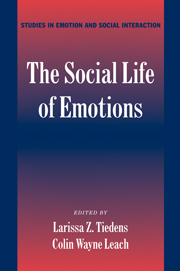Book contents
- Frontmatter
- Contents
- Acknowledgements
- List of Contributors
- The Social Life of Emotions
- Introduction: A World of Emotion
- PART I THE INTERPERSONAL CONTEXT
- PART II THE INTRAGROUP CONTEXT
- PART III THE INTERGROUP CONTEXT
- 11 Intergroup Emotions
- 12 Intergroup Contact and the Central Role of Affect in Intergroup Prejudice
- 13 Judgments of Deserving and the Emotional Consequences of Stigmatization
- 14 Group-based Emotions and Intergroup Behavior
- 15 Interpreting the Ingroup's Negative Actions Toward Another Group
- 16 Intergroup Schadenfreude
- Index
- References
16 - Intergroup Schadenfreude
Conditions and Consequences
Published online by Cambridge University Press: 01 April 2011
- Frontmatter
- Contents
- Acknowledgements
- List of Contributors
- The Social Life of Emotions
- Introduction: A World of Emotion
- PART I THE INTERPERSONAL CONTEXT
- PART II THE INTRAGROUP CONTEXT
- PART III THE INTERGROUP CONTEXT
- 11 Intergroup Emotions
- 12 Intergroup Contact and the Central Role of Affect in Intergroup Prejudice
- 13 Judgments of Deserving and the Emotional Consequences of Stigmatization
- 14 Group-based Emotions and Intergroup Behavior
- 15 Interpreting the Ingroup's Negative Actions Toward Another Group
- 16 Intergroup Schadenfreude
- Index
- References
Summary
People can feel just as strongly about their membership in groups as they do about any other feature of their lives. Recent theory and research marrying social identity theory with appraisal and other approaches to emotion is beginning to show how important emotions are to the group and intergroup aspects of social life. In this chapter, we develop the intergroup emotion perspective by focusing on schadenfreude – a malicious pleasure that group members can take in the suffering of another group. We believe schadenfreude is an important, if somewhat obscure, emotion because it is an insidious expression of a malevolent feeling that can do serious harm to intergroup relations.
THE SOCIAL IDENTITY THEORY OF INTERGROUP RELATIONS
The social identity theory tradition has been particularly useful in defining the group level of self and specifying the relations between groups that can structure psychological experience (Tajfel & Turner, 1986). Although Tajfel (1978, p. 63) referred to the “emotional significance” attached to group membership as a defining feature of social identity, classic social identity theory offers a rather generic account of the affective side of group life. Thus, the evaluation of ingroups and outgroups is typically characterized along a single dimension of valence that ranges from the self-directed positivity of ingroup favoritism to the other-directed negativity of outgroup derogation. This fairly simple characterization of group evaluation is belied by other aspects of a theoretical framework that emphasizes the complexities of intergroup relations.
- Type
- Chapter
- Information
- The Social Life of Emotions , pp. 336 - 356Publisher: Cambridge University PressPrint publication year: 2004
References
- 17
- Cited by



